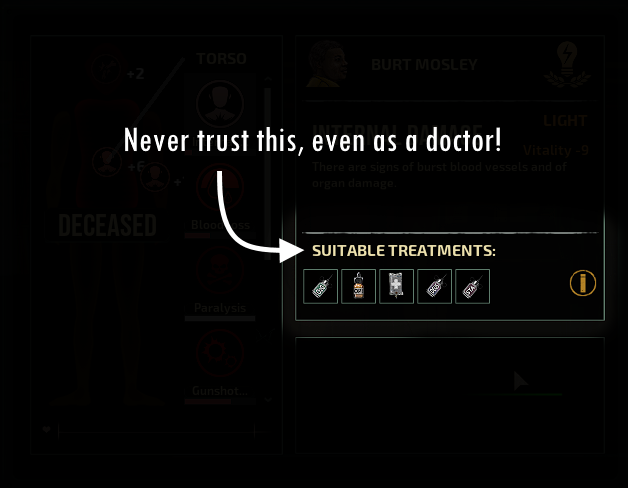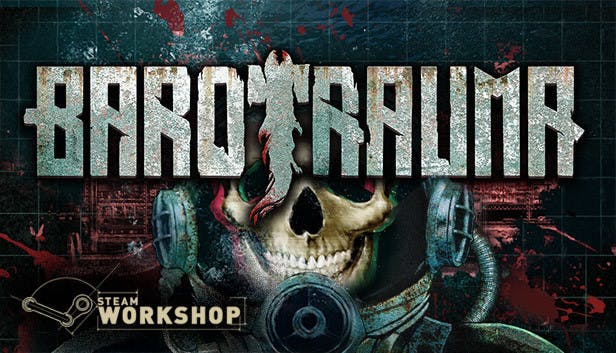Lots of people died in Barotrauma for not knowing how to treat patient correctly, this is an updated for the recent medical system overhaul. All information is obtained from the game’s code, and is reaffirmed by my extensive medical experience. If you want to how to save life in Barotrauma, you better read this guide.
Afflictions
Afflictions are buffs and debuffs that effect the patient. They are typically shown in the health overlay. These are brief descriptions of them and treatment options. A few afflictions that can only be applied through console commands are not shown. The affliction type correlates with what drugs are used to treat it. Some afflictions are unique and do not have a type.
Internal Damage
Type: Damage
AKA blunt force trauma. A common injury caused by blunt damage, such as falls, or being beaten with a blunt object. Treat with opiates.
Lacerations
Type: Damage
Caused by sharp objects. Treat with opiates.
Bite Wounds
Type: Damage
Caused by many hostile creatures, usually bleeding is also inflicted. Treat with opiates.
Gunshot Wounds
Type: Damage
A severe wound. Treat with opiates.
Bleeding
Type: Bleeding
A bleeding wound caused by various things. Treat with plastiseal, bandages, or antibiotic glue.
Burns
Type: Burn
Burns caused by electrical mishaps, welding tools and cutters, and more. Treat with opiates or bandaging.
Low Oxygen
Many things cause this, such as heavy opiate usage, welding fuel in masks or suits, a lack of oxygen in the sub, or being in water without a mask or suit. Treat with CPR when the patient has oxygen available to them. Avoid treating other afflictions requiring opiates. If you are not a trained medic, treat them with stabilozine, deusizine, or liquid oxygenite if not trained.
Blood Loss
Caused by bleeding, blood loss can be treated with blood packs, saline, or alien blood if necessary, but the blood loss will continue to worsen until all bleeding wounds are treated. Causes weakness.
Stun
Caused by the person disconnecting, being hit with a stun baton or stun gun dart, chloral hydrate. Many attacks and weapons also cause a short stun. The stun will go away on its own (unless the player disconnected, in which they will eventually die of “brain death”), but it can be quickly shortened with hyperactive drugs.
Barotrauma
AKA pressure. Always present when swimming outside the ship with or without a suit. If a suit is not worn the patient will soon die. Barotrauma also occurs inside the ship when there is a major leak and the patient is submerged in the water. Cannot be treated by medication.
Husk Infection
A dangerous infection caused by a husk or infected crawler bite, or an injection of husk eggs. The patient will slowly become a zombie-like creature. Treated with calyxanide, or broad-spectrum antibiotics. Once the patient completely dies from the infection, after several seconds their corpse will be reanimated by the husk parasite. After the husk dies, it will no longer resurrect.
Space Herpes
Caused by having low karma. Not treatable with medication. The afflicted player must perform good tasks to increase their karma. Can cause slowness, inverted controls, and more.
Psychosis
Caused mainly by deliriumine poisoning and exploring ruins. Will result in hallucinations, usually fires, floods, and shaking. Treated with haloperidol. If the patient has deliriumine poisoning, treat that first.
Drunk
Caused by ingesting ethanol. Not treatable. Too much ethanol will cause alcohol poisoning, leading to suffocation, which should be treated with a constant supply of oxygen-providing drugs until the drunkenness subsides.
Opiate Withdrawal
Caused when an opiate addiction forms and is not treated. The withdrawal can be treated with opiates, but naloxone should instead be used to get rid of the addiction. Can kill if left untreated.
Opiate Overdose
Caused by ingesting large amounts of opiates. Oxygen loss will also occur in an overdose. If the overdose becomes lethal, immediately administer naloxone, and prepare to treat their oxygen loss as well.
Opiate Addiction
Caused by using opiates frequently or heavily. Treated with naloxone.
Radiation Sickness
Being exposed to a reactor explosion causes this. The affliction will constantly cause burns all over the body, eventually causing death. Can be temporarily treated with opiates or bandages, and antirad will cure the affliction.
Morbusine Poisoning
A deadly toxin that will kill the patient unless cured with the antidote.
Sufforin Poisoning
A deadly toxin that will kill the patient unless cured with the antidote.
Cyanide Poisoning
A deadly toxin that will kill the patient unless cured with the antidote. Slowest of the other two poisons.
Deliriumine Poisoning
A non-lethal toxin that causes psychosis. Cured with the antidote.
Paralysis
Caused by the green cells in the thalamus. Will slowly slow the patient until they go unconscious until cured. Cured with anaparalyzant.
Slow Metabolism
Lengthens other effects such as vigor. Caused by tonic liquid.
Hyperactivity
Caused by meth or hyperzine. Greatly increases speed. Hyperactive drugs can cause psychosis.
Husk Infection Resistance
Caused by antibiotics, reduces the chance of a husk infection.
Psychosis Resistance
Caused by ethanol ingestion. Self-explanatory.
Vigor
While affecting the patient, their damage will be halved. Caused by anabolic steroids.
Paralysis Resistance
Caused by anaparalyzant. Self-explanatory.

Pharmacology
This section will go over every drug in detail. Including the crafting materials for them, their usage, and more.
Example
Treats: Damage (5-10|60-120) The affliction(s) or affliction type(s) the drug treats, as well as the minimum and maximum amount of the affliction that is treated per second, depending on medical skill, as well as the min/max of the total amount the drug will treat. In this example, the drug treats 5 damage per second if you’re unskilled, and 10/s if skilled. However the drug lasts 12 seconds (see below), so the total amount of damage it treats is 60 to 120.
Causes: Damage (8-2) Afflictions that the drug will cause, the minimum is higher because a lower medical skill typically will cause more damage than if you are skilled. If the maximum is zero, it means the drug will not cause the affliction if the skill check passes.
Length: 12 How long the effect of the drug will last in seconds.
Uses: 2-4 The min and max amount of uses the drug has, depending on medical skill.
Recipe: Cheese Materials to make the drug.
Bandage
Treats: Bleeding (6-9), Burn (10-15)
Length: 1s
Uses: 3
Recipe: Organic Fiber
Plastiseal
Treats: Bleeding (6-7|30-35), Burn (6-7|30-35)
Length: 5s
Uses: 4
Recipe: Bandage, Elastin
Antibiotic Glue
Treats: Bleeding (1-2), burn (1-2)
Causes: Damage (1.25-0|25-0)
Length: 20s
Uses: 2-5
Recipe: Stabilozine, Broad-Spectrum Antibiotics, Elastin
Morphine
Treats: Damage (2-5|20-50), Burn (2-5|20-50), Opiate Withdrawal (3|30)
Causes: Oxygen Loss (3-2|30-20), Opiate Addiction(2.5-0.5|25-5), Opiate Overdose(2-1|20-10)
Length: 10s
Uses: 1-2
Recipe: Opium x2
Note: While the total amount of oxygen loss from morphine (and other opiates) seem bad, remember that it is over 10 seconds, and oxygen loss automatically reduces as long as the patient is breathing on their own and has access to oxygen. This is only dangerous if overdosing on opiates, or if the patient is struggling to breath or isn’t at all.
Fentanyl
Treats: Damage (5.75-15|28.75-75), Burn (5.75-15|28.75-75), Opiate Withdrawal (20|100)
Causes: Oxygen Loss (8-6|40-30), Opiate Addiction (6-1.5|30-7.5), Opiate Overdose (6-4.5|30-22.5)
Length: 5s
Uses: 1-2
Recipe: Morphine, Adrenaline, Ethanol
Saline
Treats: Blood Loss (3-6|15-30)
Length: 5s
Uses: 1-4
Recipe: Sodium, Chlorine
Note: Deconstructing a swim bladder provides saline.
Blood Pack
Treats: Blood Loss (4-8|60-120)
Length: 15s
Uses: 1-2
Recipe: Alien Blood, Saline, Stabilozine
Deusizine
Treats: Damage (1.5-3|45-90), Oxygen Loss (1.5-3|45-90), Blood Loss (1-1.5|30-45)
Causes: Burn (0.25-0.125|7.5-3.75)
Length: 30s
Uses: 1-2
Recipe: Antibiotic Glue, Fentanyl, Liquid Oxygenite
Liquid Oxygenite
Treats: Oxygen Loss (1.65|99)
Causes: Internal Damage (1.5-0.5|90-30)
Length: 60s
Uses: 1-2
Recipe: Tonic Liquid, Stabilozine, Oxygenite Shard
Note: Liquid Oxygenite may explode upon impact.
Calyxanide
Treats: Husk Infection (1-4|20-40)
Length: 20-10s
Uses: 1-2
Recipe: Husk Eggs x0.25, Broad-Spectrum Antibiotics, Stabilozine
Haloperidol
Treats: Psychosis (25-100)
Length: 1s
Uses: 1-2
Recipe: Lithium, Carbon, Chlorine
Naloxone
Treats: Opiate Withdrawal (1-2|30-60), Opiate Addiction (1-2|30-60), Opiate Overdose (1-2|30-60)
Length: 30s
Uses: 1-2
Recipe: Morphine, Stabilozine
Broad-Spectrum Antibiotics
Treats: Husk Infection (0.25-0.5|15-30)
Causes: Husk Resistance (300-600 for 60s), Internal Damage (1-0.55|60-33)
Length: 60s
Uses: 1-2
Recipe: N/A
Note: Obtained from deconstructing Slime Bacteria.
Stabilozine
Treats: Damage (0.5-1|5-10), Burn (0.5-1|5-10), Oxygen Loss (1-2|10-20)
Length: 10s
Uses: 1-2
Recipe: N/A
Note: Obtained by deconstructing swim bladders.
Treatment Protocols
The patient is not moving, and it is unclear if they are unconscious, dead, or stunned. Observe the following image.

- If you have a health scanner headset equipped, hovering over them will tell you if they are alive, and what’s wrong with them.
- If you have no headset, approach them and open the health overlay with H. If “DECEASED” appears they are dead. If not, call for a doctor and try to find what the problem is.
- If the patient has no problems wrong with them, but continues to lie there lifeless, it’s possible they were stunned by someone or something, they’re ragdolling, or they’ve disconnected.
The patient is unconscious and not breathing, slowly nearing death. They may or may not have other injuries.
- Ensure the patient can receive air. Get them out of water, or give them a mask/suit with oxygen.
- Perform CPR if you are trained. Press H to open the overlay to do so.
- If the victim is bleeding, administer blood while also giving CPR, and patch up any wounds.
- Do NOT administer opiates (opium, morphine, fentanyl) until the patient’s breathing is at 100%.
The patient has a husk infection. This is apparent because they may have a tendril hanging out of their mouth, or the health headset or overlay has told you so.
- Immediately inform the crew of the outbreak
- Administer calyxanide and keep watch of the patient to ensure the infection goes away
- If you do not have calyxanide, antibiotics can be used, but it will cause internal damage, and will not be as strong as calyxanide.
- Begin checking the entire crew for husk infections. Even once everyone is checked, repeat checks frequently for the rest of the mission.
- Ensure that all husk eggs and sources of infection are secure.
- Get another medic or someone with a health headset to check you for husk if you believe you may of been infected.
- If you or someone else has minor injuries that aren’t worsening rapidly, do not waste medication on them. In campaign, all afflictions will go away the next round.
- If you are trying to treat someone, it is important not to trust the suggested treatment options. Even for a trained medic, these are frequently incorrect.
- Internal damage, bite wounds, gunshot wounds, and lacerations are all treated with opiates such as opium, morphine, and fentanyl.
- Bleeding wounds are treated with bandages, plastiseal, and antibiotic glue.
- Burns can be treated with opiates, bandages, plastiseal, and antibiotic glue.
- Blood loss is treated with blood packs, saline, or alien blood.
- CPR is not recommended if you aren’t a doctor unless there is no doctor nearby. Stabilozine, deusizine or liquid oxygenite is highly recommended as an alternative.
- If a patient is very close to death, injecting steroids is extremely helpful.
- If a patient is about to die of blood loss, give them a blood pack quickly to buy some time to bandage them up.

Related Posts:
- Barotrauma: 100% Achievements Guide
- Barotrauma Complete Job Talent Trees
- Barotrauma Crashing the Organ Donor Market
- Barotrauma How to Add Items into Cabinets, Lockers, Shelfs.
- Barotrauma: The Ultimate Diving Guide
